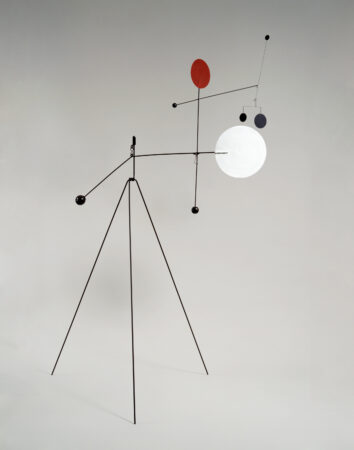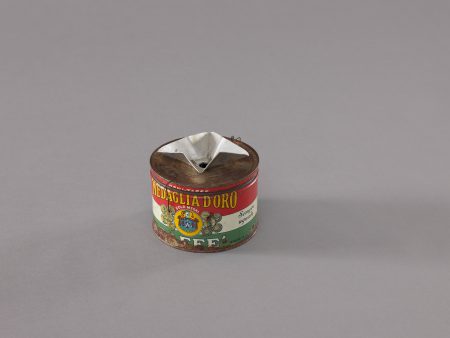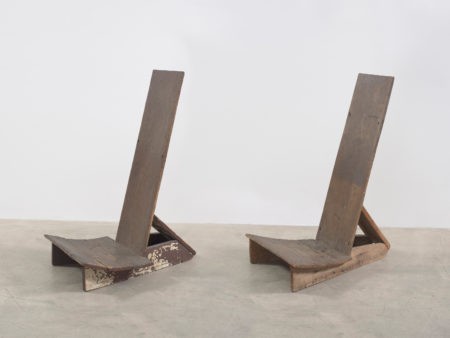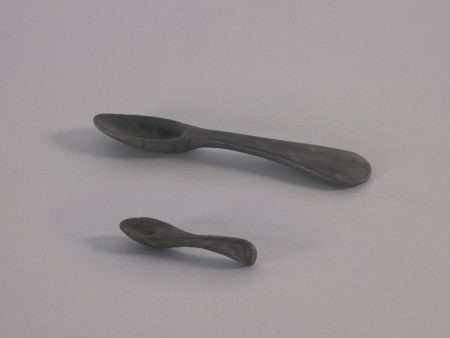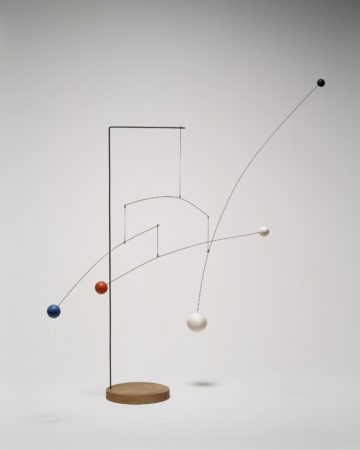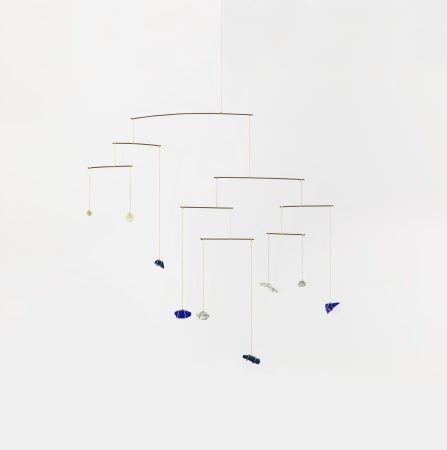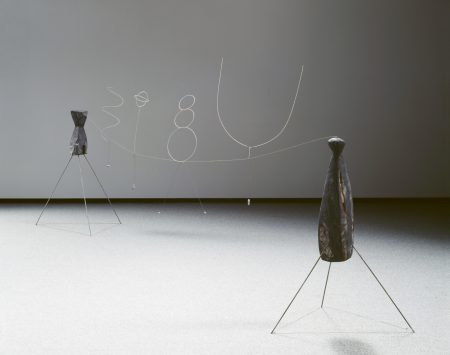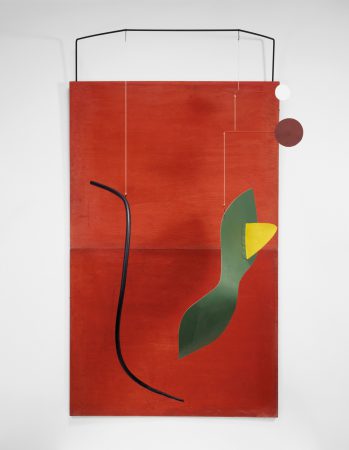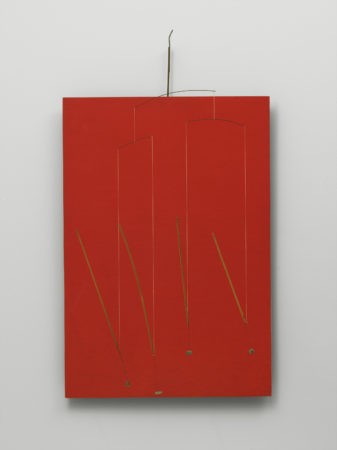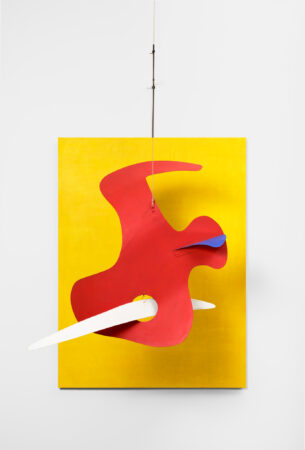Archive
See highlights from 1930–1936 on the timeline Shift to Abstraction
Works
Chronology 121
Calder presents Bonnie Bird, one of the lead dancers of Panorama, a brooch in the shape of a bird.
Bell-Kanner 1998, 80Calder and Louisa visit Charlotte Whitney Allen in Rochester, New York. While there, Calder constructs the large standing mobile she had commissioned for her garden and he gives a performance of Cirque Calder.
CF, Calder to Allen, 24 SeptemberThe Calders spend the winter in an apartment at 244 East Eighty-sixth Street and Second Avenue, New York. Calder rents a small store and converts it into a studio.
Calder 1966, 156; Calder to Thomson, April 1936
Thomas H. Fisher, husband of choreographer Ruth Page, writes to Calder: Ruth [Page] and I have the novel idea that you should construct for her a large scale ‘mobile’ to be used alone on the stage, with music and lights between her ballets. The idea would be to enlarge such a
mobile as the one I saw in the Museum of Modern Art to stage proportions using different colored objects in motion and then playing lights on the mobile from the wings and elsewhere in the theatre. The music would, perhaps, be something like Varese or something else which would be suitable to the particular mobile being displayed.
Calder again collaborates with Graham, making a group of six mobiles—”visual preludes”—for her dance Horizons.
CF, project file; "Martha Graham and Dance Group," 193624 December: The large ‘overhead’ mobile should be in its box in your basement (awaiting my pleasure). Do you think you would care to put it up anywhere during la semaine folle—only a suggestive question—because Ruth Page wishes me to do an object which she can use, here,
and in Chicago, to pinch-hit for one of her solo dances—and I thought of that one.
1936
Page writes to Calder: I have been experimenting with my brass mobile which you sent here and have decided that it is much more beautiful without me than with me. Any movements of mine just spoil it. However, we tried it just in the room here with lights and music and it is a thrilling dance all
by itself and we would have to produce it just by itself with lights and music. Blow an electric fan on it so that it moves very slightly. But it seems to me there should be a little group of 2 or 3 to make an impression—like 3 short dances.
George Platt Lynes photographs Calder.
CF, photography file“Mobiles and Objects by Alexander Calder” is held at the Pierre Matisse Gallery, New York.
CF, exhibition fileFirst Hartford Music Festival, Wadsworth Atheneum, presents Erik Satie’s symphonic drama Socrate. Virgil Thomson and A. Everett “Chick” Austin, Jr., have commissioned Calder to create the mobile decor for the performance. As the singers stand still at either end of the
stage, Calder’s simple geometric objects in space enact a series of movements. Later that night the festival continues with Paper Ball: Le Cirque des Chiffoniers, designed by Pavel Tchelitchew and featuring thirteen processions of paper costumes created especially for the event. For Soby’s procession, Calder contributes A Nightmare Side Show, a suite of animal costumes designed to wear over evening clothes.

Graham premieres Horizons at the Guild Theatre in New York City. The program note reads: The “Mobiles,” designed by Alexander Calder, are a new conscious use of space. They are employed in Horizons as visual preludes to the dances in this suite. The dances do not interpret the “Mobiles,” nor
do the “Mobiles” interpret the dances. They are employed to enlarge the sense of horizon.
“Cubism and Abstract Art” is presented by Alfred H. Barr, Jr., at the Museum of Modern Art, New York. Calder is represented by three works: Objet Volant, a large mobile commissioned to hang on the flagpole outside the museum, announcing the show; A Universe; and a mobile.
CF, exhibition file
Calder performs Cirque Calder in New York at the Pierre Matisse Gallery.
AAA, Calder to Bunce, 26 MarchErik Satie’s Socrate with Calder’s mobile decor is performed at the Colorado Springs Fine Arts Center.
CF, project file
Galerie Charles Ratton, Paris, presents “Exposition surréaliste d’objets.” Calder contributes a mobile.
CF, exhibition file
Roland Penrose’s “International Surrealist Exhibition” at his New Burlington Galleries, London, includes two sculptures by Calder, among them Requin et Baleine. André Breton writes the preface to the catalogue.
CF, exhibition fileThe Calders vacation at Eastham on Cape Cod.
AAA, Calder to Bunce, 13 JulyJulien Levy’s Surrealism, the first English text on the subject, is published in New York. Levy writes: It is impossible accurately to estimate the relative importance of the younger surrealists, until aided by the perspective of time. Outstanding among the newcomers seem to
be Gisèle Prassinos, Richard Oelze, Hans Bellmer, Leonor Fini, Alexander Calder, and Joseph Cornell . . . Calder is sometimes surrealist and sometimes abstractionist. It is to be hoped that he may soon choose in which direction he will throw the weight of his talents.
Calder is commissioned by architect Paul Nelson to design a trophy for CBS’s Annual Amateur Radio Award. The work is William S. Paley Trophy for Amateur Radio.
CF, project file; Calder 1966, 155Calder’s Praying Mantis and Object with Yellow Background are included in the exhibition “Fantastic Art, Dada, Surrealism,” organized by the Museum of Modern Art, New York.
CF, exhibition fileCalder performs Cirque Calder in his apartment at 244 East Eighty-sixth Street and Second Avenue, New York.
AAA, Calder to Bunce, 9 December










